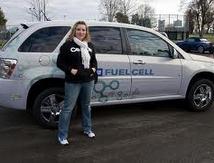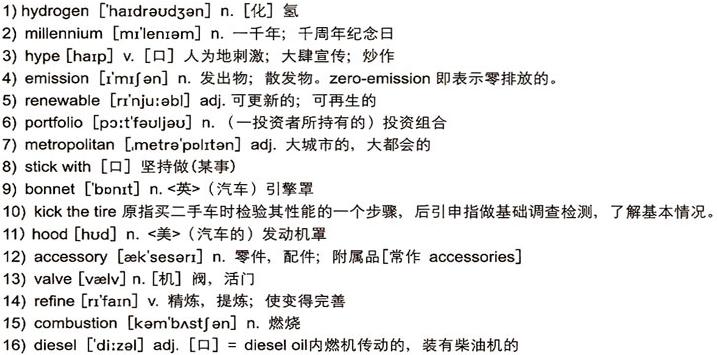伦敦试验者为我们剖析:氢能作为公共交通工具能源的可行性。
Gareth: Well, from cars to buses and from Berlin to London, I'm back in London, actually on the bus along the RV1 bus route going on the south bank on the Thames. Now, if you are a Londoner, then I know what you're thinking, “Didn't we once have hydrogen-powered buses on this route?” Well, you're right. We did. So what happened? We're back to 16)diesel now.
Well, those hydrogen buses were actually just on a 24-month trial that started in 2004. London was one of nine cities on that study aimed at establishing the viability of hydrogen as a fuel for public transport. Overseeing it all in the capital was Mike Weston. He's operations director for buses at Transport for London. And I'm on my way to his office right now. I'm very keen to find out what that trial revealed.
Mike: We learnt it was viable. It was reliable. It had some limitations. The main limitation being around operating range of the vehicle. And so, in coming up with our next project, we were…we…we set some…ourselves some clear objectives. The next demonstration had to move the technology forward; it couldn't just be a case of buying some more buses, more similar buses that performed in the same way and did the same job. So we…we went out to a competitive tendering process, to the market. And we said that the next hydrogen buses must have an operating range of about 18 to 20 hours a day and must be able to run on the RV1 for the whole duration of the operating day.  Gareth: How do you manage to extend the distance they can travel?
Gareth: How do you manage to extend the distance they can travel?
Mike: Okay. The main way in which we've managed to extend the operating range of the buses is…is by combining the fuel cell technology with hybrid technology. We already have in London a number of diesel hybrid buses, and the hybrid system is an on-board energy system that…you stores excess energy from the…from the engine and also from the braking system. That allows more efficient use of the vehicle.
格瑞斯: 谈完小车我们来谈谈大巴,去完柏林,来伦敦看看。我现在回到了伦敦,正坐在公车上,是沿伦敦泰晤士河南岸行驶的RV1线路公车。如果你是伦敦本地人,那我知道你一定在想:“本来不是有氢动力公车走这条路线的吗?”嗯,没错,曾经是有的。我们现在又用回柴油机驱动的大巴了,这是怎么回事呢?
其实,那些氢动力公车只是试运行了两年,从2004年开始的。当时有一个项目旨在研究以氢能作公共交通工具能源的可行性,伦敦是九个试验城市之一。在英国首都监理这一项目的是迈克·韦斯顿,他是伦敦交通局的公车服务营运总监。现在,我就是坐车往他办公室去。我很想知道那次的试运行得出了什么结论。
迈克: 我们了解到,氢动力巴士作为公车是可行的,是可靠的,但也有一些局限,最大的局限主要是巴士的可行驶里程。所以,在进一步的项目规划中,我们订下了一些清晰的目标。下次的试验必须把科技再推进一步;不能仅仅是购置更多的巴士,不该购置表现和功能都大同小异的巴士。因此,我们把项目推向市场,进行公开竞标,要求下一批氢动力公车必须每天能跑18至20个小时的路,而且必须能按RV1线路营运日的全程时数行驶。
格瑞斯: 那你们是怎样延长这些氢动力巴士的行驶里程的呢?
迈克: 我们延长这些巴士的行驶里程主要是把燃料电池技术跟混合动力科技结合起来。我们已经有一些柴油混合动力公车在伦敦营运。混合动力系统是一种车载能源系统,引擎和刹车机件产生的剩余能源会通过这一系统被储存起来,让汽车实现更节能高效的运作。
Gareth: Storage is an issue, isn't it? I mean, how big is the…the hydrogen tank on the bus?
Mike: The hydrogen is stored on the roof of the vehicle in…in six circular tanks about two metres long each. And…and the bus will carry about 45 kilograms of hydrogen, which actually becomes a bit of a challenge in the future, because actually we…we've struggled to find that storage space on…space on double-deck vehicles.
Gareth: So do you see London as a bit of a leader, I mean you've been part of this kind of pan-European project? But London, as a city, are you…are you proud of what you and London have achieved in bringing these buses onto the streets of London and making them work?
Mike: Yeah. I mean certainly…certainly this next project is…is fairly unique, because it will be one of the first cities in the world to have buses that can…can have the operating range and perform very…on a very similar basis to diesel. But we are working with … we…we have an alliance with a number of other worldwide cities. We're working very closely with about a dozen other cities around the world, who are also trying different types of hydrogen bus technology. And the challenge is ultimately that the…the…probably the next barrier to the roll-out of this technology is cost. Still relatively expensive—these buses cost about four or five times the cost of a conventional single-deck bus. So it's still a big barrier. And the one thing that will help change that is volumes (volume). So we need more cities around the world to be buying hydrogen buses and to increase the volume so that we can get the cost down and make them more economical.
格瑞斯: 贮存空间是个问题吧?我意思是,那些巴士上的液氢储罐有多大呢?
迈克: 氢燃料贮存在车辆的顶部,有六个分别长两米的圆柱状储罐,共装有大约45千克的液态氢。这对氢动力公车将来的发展的确是构成了一定的挑战,因为在双层巴士上,我们一直很难找到足够的空间来放置那些储罐。
格瑞斯: 你参与过这样一个覆盖欧洲多国的试验项目,伦敦作为一个城市而已,有此成果,你觉不觉得伦敦是这方面的领头羊?能成功引入这些公车在市内道路上行驶,你会为自己和伦敦在这方面的成就感到骄傲吗?
迈克: 会的,这个新计划绝对是相当无可比拟的,因为伦敦将会一马当先,在全球率先拥有里程性能可媲美柴油机驱动汽车的氢动力公车。而我们也跟世界其他一些城市保持着研发同盟关系。现时,我们跟世界各地的十几个城市紧密合作,它们也在努力尝试不同类型的氢动力巴士技术,最终的挑战……普及推广这一技术过程中要解决的下一个障碍很可能就是成本的问题。这些巴士的成本是一般单层巴士的四到五倍,花费仍相对高昂,所以始终是一大障碍。有助改变这一现状的就是这类巴士的增量应用,因而我们需要全球更多的城市继续购置这些氢动力巴士,量的提高会使成本降低,使其变得更经济适用。
Gareth: I have to say I've had a lovely time on this program with the believers and those hydrogen evangelists. But back here in London it's pretty much down to earth. I mean, yes, there are quite a few hybrid cars around these days, but for the most part, the streets remain choked with petrol and diesel vehicles. It's a reminder that, whilst they've cracked fuel cell technology, the costs really need to come down, and designs need to be refined. Hydrogen isn't hype anymore, but then neither is it everyday reality. Well, not quite yet anyway.
格瑞斯: 我得说,很高兴在这次的节目上跟各位氢动力的传道先驱和信徒们高谈远景,但回到伦敦这里,还是要老实面对现实。我的意思是,没错,最近是有那么一些混合动力汽车在城中行驶,但街道上大部分还是充斥着汽油及柴油车辆。这提醒着我们,虽然他们在燃料电池技术方面有所突破,但成本确实需要降下来,设计也需要进一步改良优化。“氢动力”已不再是概念炒作,可惜也未完全融入我们的日常生活,还挺有点距离呢。

